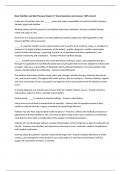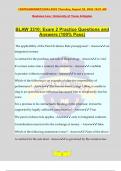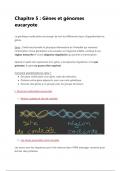Basic Nutrition and Diet Therapy Chapter 17 Exam Questions and Answers 100% Correct
In the area of nutrition care, the ______ carries the major responsibility of medical nutrition therapy. -
Answers registered dietitian
Working closely with the physician, the dietitian determines individual - Answers nutrition therapy
needs and a plan of care.
Nurses are in a unique position to provide additional nutrition support by reffering patients to the -
Answers dietitian when necessary.
_____ is a specific nutrition service and procedure that is used to treat an illness, injury, or condition; it
involves an in-depth nutrition assessment of the patient, nutrition diagnosis, nutrition intervention
(which includes diet therapy, counseling, and the use of specialized nutrition supplements), and
nutrition monitoring and evalutation. - Answers Medical nutrition therapy.
______ a health care professional who treats the effects of disease, injury, and congenital disorders
through the application of scientifically based exercise principles that have been adapted to enhance the
strength, endurance, and mobility of individuals with functional limitations or for those patients who
require extended physical conditioning. - Answers kinesiotherapist
The dietitian determines nutrition needs, plans and manages nutrition therapy, evaluates the plan of
care, and records results. Throughout this entire process, the nurse helps to - Answers develop, support,
and carry out the plan of care. Successful care depends on the close teamwork of the dietitian and the
nurse.
A nursing diagnosis may include several issues that are nutrition related, such as - Answers diarrhea,
malnutrition, failure to thrive, and fluid volume deficit.
Unfortunately, ____ is common in hospital settings. - Answers malnutrition.
Many factors are involved in malnutrition for example, - Answers lack of appetite because of pain,
medicine-induced anorexia, surgery, emotional and psychologic distress).
Patients may also have reduced food intake because of - Answers conflicts with medical procedures or
appointments during mealtimes. The nurse may be able to help resolve such conflicts by coordinating
meal-delivery times with a consideration of the patient's scheduled procedures.
Patients who are discharged without a proper interpretation of their prognosis or plan of continued care
may be - Answers noncompliant and experience unnecessary stress, confusion, medical complications,
and hospital readmission.
Learning about the patient's nutrition needs should begin with - Answers hospital admission or initial
contact, carry through the entire period of care, and continue in the home environment, with the
support of community resources as needed.
, To assess nutrition status and provide person-centered care, as much - Answers information as possible
about the patient's situation is collected.
Data obtained during the nutrition assessment are organized into five categories: - Answers
Food-/Nutrition-related history
Anthropometric measurements
Biochemical Data, Medical tests, and procedures
Nutrition focused physical findings
Client history
Clinicians should be aware that _______ energy intake is quite common and that this may affect dietary
assessment and recommendations. - Answers underreporting.
Specific questioning about various supplements (e.g. vitamins, minerals, multivitamin/mineral
combinations, and herbs) is more likely to - Answers yield accurate answers and to provide insight into
overall consumption.
Patients often do not report - Answers supplement intake.
Allergies and intolerances should be noted so that - Answers alternative recommendations meet
nutrition needs without causing negative reactions.
The ______ or ____ of energy expenditure is another important consideration when providing nutrient
recommendations. - Answers overreporting, underreporting
Practive taking correct _____to avoid errors, and maintain proper equipment and careful technique. -
Answers anthropometric measurements
Height, weight, and body mass index are the most common _____ that are used in clinical practice, and
they are provide basic nutrition risk parameters. - Answers anrthropometric measurements
Depending on the situation, _____ ___ ____ and ____ ____ may be taken as well. - Answers Body
composition measurements and waist circumference.
How to measure height: Use a fixed ___ ___ against the wall, if possible, or use the moveable measuring
rod on a platform clinic scale. - Answers measuring stick
Children who are younger than 2 years old should be measured while they are ____ _____ with a
stationary headboard and a movable footboard. - Answers lying down
Alternative measures for non-ambulatory patients provide estimates for people who are - Answers
confined to a bed, who cannot stand up straight, or who have lower-body amputations.






